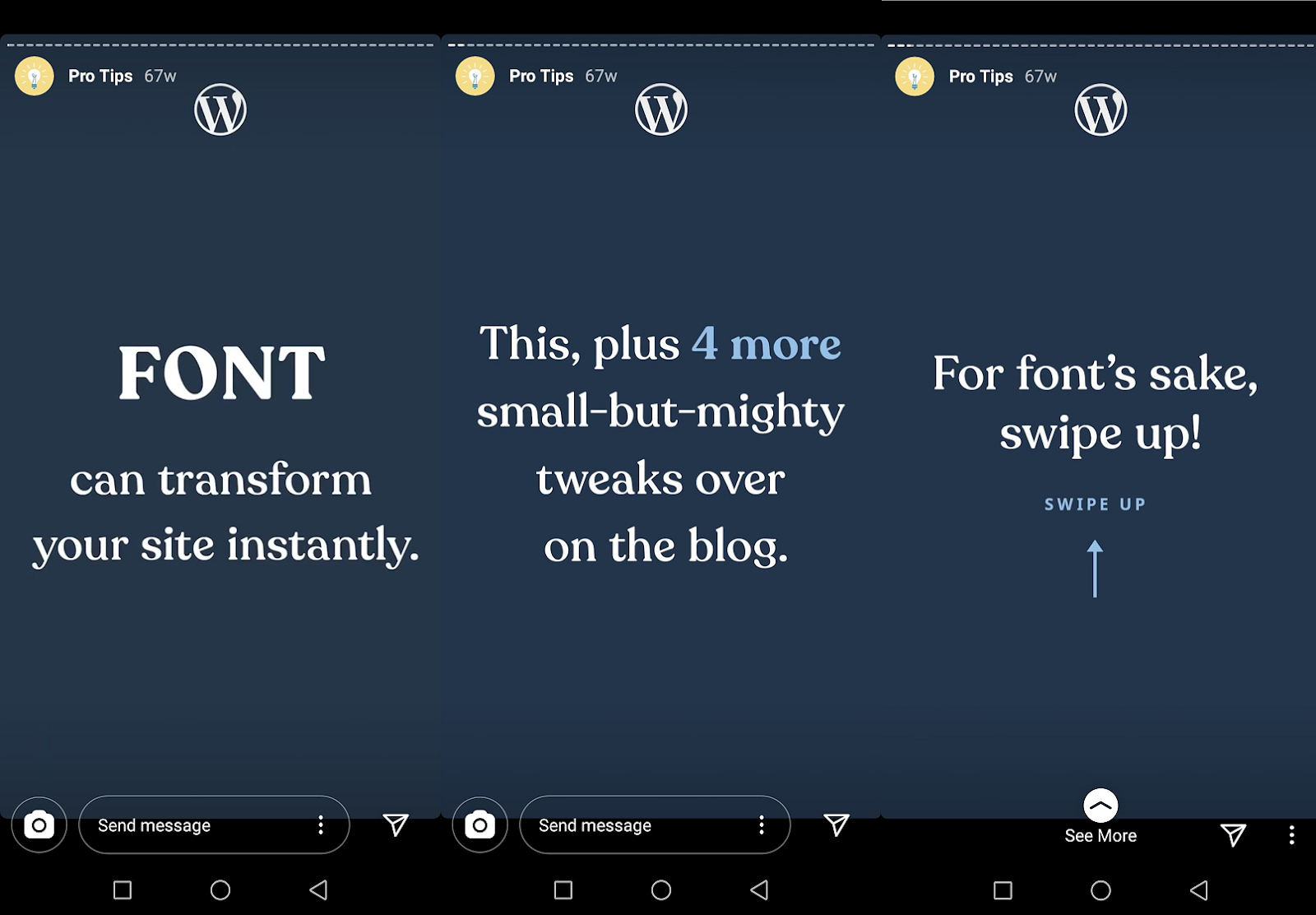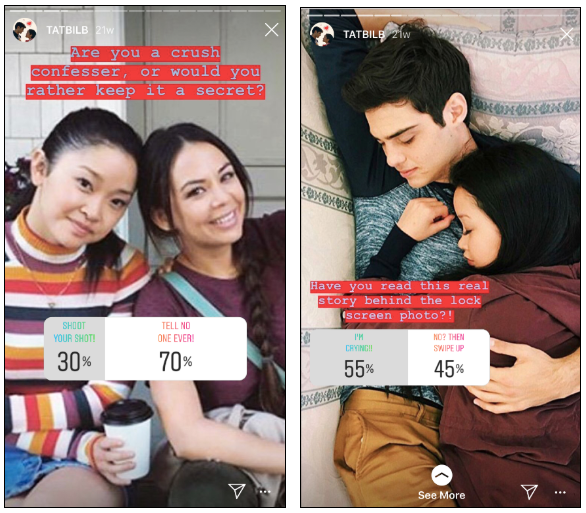A core goal for any type of marketing is to build one’s brand authority. In a vastly competitive arena with no limit to the marketing messages audiences are subjected to consuming each day, they often turn to tried-and-tested products and services. Consumers are more loyal to brands they can trust—and so the more trust an individual has in a brand, the higher the likelihood of them giving sales.
96% of the most successful B2B content marketers say their audience views them as a trusted resource. Why? Content marketing satisfies audiences’ informational needs, getting them to learn more about the services a brand provides, why they matter, and what kind of impact they can expect it to have on their lives. That’s why blogs remain an effective marketing tactic for driving traffic to websites even now.
That makes social media the perfect partner for content marketing, especially when it comes to Instagram: a platform tailor-made to attract immediate interest in anything visually exciting for audiences. As the second most-used platform after Facebook, it’s prime ground for brands looking to direct more traffic to their WordPress blogs. Here is how to do it.
1. Use Your Instagram Bio as a Call-to-Action
While an Instagram profile gives little in the way of customization options, there is one key area you should never neglect: the bio. Not only does optimizing your Instagram bio leave space for much-needed keywords for search engine optimization, it can act as a profile-wide call-to-action promoting your blog website.
@Bookbento
First: input your WordPress blog as your main website link on your profile. This is the only clickable link you will get on your entire Instagram profile, so make it count. You can either use the link to direct to your blog homepage, or to a specific post, which is recommended if you want to promote either your latest or most popular entries.
Next, add a call-to-action phrase in your bio encouraging visitors to click the link to visit your blog. If you decide to promote a specific post, add the title or topic to stoke more interest. This way, you may attract more readers likely to engage with your post.
Tip: To highlight your link and call-to-action phrase, add emojis or special characters to draw the eye where you want them. Colored arrows are a frequent choice, since a few point directly downwards to the link.
2. Post Useful Excerpts from Each Entry
Give your followers a taste of the blog content itself by sharing excerpts from each entry through Instagram feed posts and Stories. Formatting your hardest-hitting quotes, valuable insights, and practical how-to’s can easily establish your blog as a consistent and reliable source of information.
For Instagram feed posts, it’s just a matter of adding text to an image and placing it into your scheduled queue. The full blog title can then be mentioned in the caption alongside a call-to-action phrase to click the link in your bio.
If you want to showcase more bite-sized bits through Instagram Stories, you’ll need to approach them a little differently. While Stories itself already has limited font styles and features like gif inserts and stickers, you can spruce up your base image first.
By downloading an Instagram Stories editor (like Made, which is available on both iOS and Android) you can easily formulate great-looking text posts inside the app and then directly upload to Stories. If your business account has more than 10,000 followers, it gets a bonus: the Swipe Up feature, which allows you to add a link directly to your Stories so followers can access the blog post you’re referencing directly.

@Wordpressdotcom
Tip: Don’t forget to save these Story posts as Highlights on your main profile when you’re done to keep them accessible to everyone past the 24-hour mark.
3. Repurpose Blog Visuals for Social Media
Using visuals in blog posts is a best practice aimed at making content easier to consume. Visuals reinforce the message the blog is trying to communicate, help break up the text for easier reading, and act as aids and examples for tips and tutorials.
To diversify your Instagram posts and promote your blog in a way that does not only involve sharing excerpts, repurpose blog visuals for social media use. In most cases, you can select the highlight or header image at the top and reconfigure it for Instagram posting.
By using an Instagram photo editing app like Instasize (available on both iOS and Android devices), you can take any photo and crop, rotate, and redesign as you wish. Adjusting colors, adding filters, and tinkering with shadows are all things you can do to make the photo more eye-catching on social. Adding text or borders to the image can make it different enough to not look like an exact duplicate of what’s on your blog page.
You can also use a plugin, like WP Social Post, to automatically publish posts from your website on your Instagram page. The plugin allows you to create Instagram posts for all of your new WordPress blog posts, WooCommerce products and custom post types. The free version is fairly straightforward, while the pro version adds options for hashtags, delay between posts, image resizing and more.
4. Use Video to Showcase Your Best Insights
According to recent research, 92% of marketers who use video in 2020 claim it as an important part of their marketing strategy, the highest of any year since 2015. 88% also report video gives them a high ROI. In this case, if you have enough time and resources to put together simple videos for your Instagram profile, it does not hurt to test whether videos can be effective for your audience.
Gather some of the best content you have on your blog and script them into video format. This is a good strategy for grouping similar blog posts together under one major topic umbrella. You can then release it as a rundown in one of three ways: Instagram posts, Instagram stories, or IGTV.
IGTV has an edge over the rest in that it allows for long-form video content, great for more lengthy explainers. The biggest draw for marketers who need to direct traffic to their WordPress blog, though, is that links in IGTV descriptions are clickable, unlike those in other Instagram posts. By making a video summarizing your blog content, you can then link the individual posts in your caption to bring viewers over for further reading.
5. Interact with Readers and Followers
Social media gives unprecedented opportunities for brands to interact with followers directly. While a WordPress blog may have a comment section for users to share their thoughts, these may go unnoticed. To improve overall engagement with your content, it may be necessary to bring that metric out of your blog and into your social media sphere.
Respond to all comments on your blog-related posts, regardless of whether they are good or bad. You can generally get a feel of what your audience thinks and if there are points you need to improve on. As an extension of that, get them more involved and build their emotional investment in your content by granting them a say in what you do next.

@ElleUSA via Hootsuite
While you can use WordPress polls & surveys on your site, you can also use Instagram Stories to ask for followers’ opinions. You can use the Poll sticker to have users vote on your next topic or use the question and answer feature for them to make suggestions on their own. Plus, you can have your in-house thought leader come in and take any questions or clarifications about your brand’s expertise. All of these efforts can come alongside a call-to-action directing to your blog for further insight.
6. Create Instagram Campaign Schedule
Last, but definitely not the least, none of these strategies should be undertaken in a vacuum. Planning out a proper schedule coinciding with content releases on your blog should be the priority before putting out any type of content. This lets you maximize the promotion time each entry should get, while at the same time re-sharing old content to keep traffic going in those areas (especially if the entries are popular).
To make the process easier, invest in the right tools to help you organize your campaign schedule. Just like how you’d plan an editorial calendar for WordPress you can also plan a social media campaign. Identifying which blog posts go where and promoting them can take time, so research about any software you can use to help you save time, whether they offer bulk scheduling or quick reviews.
These are some of the essential tips to keep in mind when you want to drive traffic to your blog posts from Instagram. Of course, all of these efforts hinge on the strength of your blog content itself. Before undertaking promotions on any social media site, make a pass through each post you want to share and double (or triple) check to see if there are any outstanding errors, formatting issues, or mistakes to catch and correct before distribution.
Don’t be afraid to experiment. Not all strategies may work for you, and that is normal. Try each one at least once, measure your results, evaluate whether they are worth sticking with time, resources, and results wise, and adjust as needed the following months.
Stay consistent with your brand presentation across all platforms – marketing is now about having a smooth omnichannel experience for all prospective customers. Be confident that your content can provide that.
Keep reading the article at WPExplorer. The article was originally written by Kyla on 2020-06-17 14:51:01.
The article was hand-picked and curated for you by the Editorial Team of WP Archives.

